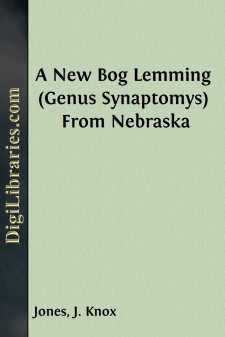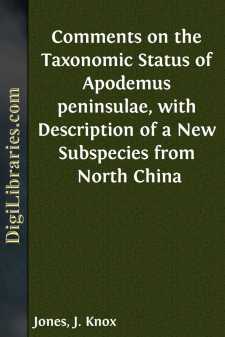Categories
- Antiques & Collectibles 13
- Architecture 36
- Art 48
- Bibles 22
- Biography & Autobiography 813
- Body, Mind & Spirit 142
- Business & Economics 28
- Children's Books 15
- Children's Fiction 12
- Computers 4
- Cooking 94
- Crafts & Hobbies 4
- Drama 346
- Education 46
- Family & Relationships 57
- Fiction 11828
- Games 19
- Gardening 17
- Health & Fitness 34
- History 1377
- House & Home 1
- Humor 147
- Juvenile Fiction 1873
- Juvenile Nonfiction 202
- Language Arts & Disciplines 88
- Law 16
- Literary Collections 686
- Literary Criticism 179
- Mathematics 13
- Medical 41
- Music 40
- Nature 179
- Non-Classifiable 1768
- Performing Arts 7
- Periodicals 1453
- Philosophy 64
- Photography 2
- Poetry 896
- Political Science 203
- Psychology 42
- Reference 154
- Religion 513
- Science 126
- Self-Help 84
- Social Science 81
- Sports & Recreation 34
- Study Aids 3
- Technology & Engineering 59
- Transportation 23
- Travel 463
- True Crime 29
A New Bog Lemming (Genus Synaptomys) From Nebraska
by: J. Knox Jones
Description:
Excerpt
In the autumn of 1952, I obtained a southern bog lemming, Synaptomys cooperi, at Rock Creek State Fish Hatchery, Dundy County, in extreme southwestern Nebraska. This locality of record is the westernmost for the species in North America. Subsequently, I reported this specimen in the literature (Univ. Kansas Publ., Mus. Nat. Hist., 7:486, 1954), provisionally assigning it to Synaptomys cooperi gossii, the subspecies occurring in eastern Nebraska. In late November of 1956, J. R. Alcorn collected three additional bog lemmings at the Rock Creek Hatchery.
These specimens from Dundy County represent a relict population that differs in several characteristics from S. c. gossii, and that differs also from all other subspecies of the species. This relict population is, therefore, here given subspecific recognition.
Synaptomys cooperi relictus, new subspecies
Type.—Adult female, skin and skull, University of Kansas Museum of Natural History no. 51617, from Rock Creek State Fish Hatchery, 5 mi. N, 2 mi. W Parks, Dundy County, Nebraska; obtained November 1, 1952, by J. Knox Jones, Jr., original no. 995.
Distribution.—Known only from the type locality.
Diagnosis.—Size large for the species, both externally and cranially; dorsal pelage dark; nasals broadly flared anteriorly (especially broad in relation to nasal length); auditory bullae small; molariform tooth-rows and incisive foramina long.
Measurements (in millimeters).—External measurements of the type specimen, followed by those of another adult female (KU 72603), are: Total length, 141, 145; length of tail-vertebrae, 24, 21; length of hind foot, 20, 20; length of ear from notch, 11, 12. The type specimen weighed 46.3 grams. Cranial measurements were taken in the manner described by Wetzel (Jour. Mamm., 36:2-3, 1955) except that he did not record the occipitonasal length. These cranial measurements of the type and KU 72603 are: Occipitonasal length, 30.2, 29.8; condylobasilar length, 27.2, 27.1; zygomatic breadth, 18.1, 17.9; lambdoidal breadth, 14.2, 13.8; length of nasals, 8.2, 8.3; breadth of nasals, 4.2, 4.0; length of rostrum, 6.6, 6.6; breadth of rostrum, 6.1, 5.9; breadth of upper incisors, 4.6, 4.2; length of maxillary tooth-row, 8.5, 8.4; length of incisive foramen, 5.8, 5.5; interorbital breadth, 3.1, 3.5.
Comparisons.—From Synaptomys cooperi gossii (specimens from eastern Nebraska and eastern Kansas, including one topotype), S. c. relictus differs in: Dorsal coloration, in comparable pelages, darker, venter lacking buffy tinge; skull averaging larger in all cranial dimensions (except rostral length, which is approximately the same), especially breadth of upper incisors and length of molariform tooth-rows; nasals broader anteriorly; auditory bullae nearly equal in size, thus relatively smaller. From Synaptomys cooperi paludis (holotype and paratypes) of Meade County, Kansas, S. c. relictus differs in: Skull averaging smaller in all cranial measurements except rostral length and breadth of upper incisors, which are approximately the same, and breadth of nasals, length of incisive foramina and length of molariform tooth-rows, which measure more; nasals relatively (48 per cent of length of nasals) as well as actually broader anteriorly; anterior border of zygomatic plate more concave; auditory bullae smaller; infraorbital foramina larger when viewed anterolaterally. S. c. relictus closely resembles S. c. paludis in color and external proportions.
Remarks.—The total population of Synaptomys cooperi relictus may be small because the only suitable habitat known to me for these mice is the dense, grassy area, approximately 100 yards wide and one mile long, around some of the rearing ponds and along the creek at Rock Creek Hatchery....










